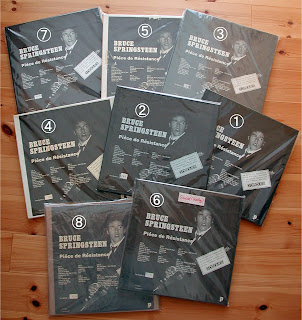 When
Springsteen’s popularity reached its peak worldwide in the mid to the late 1980s,
there was an overwhelming demand for his bootleg records, especially of
the classic titles like LIVE on Coral Records from the famous Bottom Line 1975 gig, and the original numbered copies for LIVE IN THE PROMISED LAND (see pic here), PHILADELPHIA SPECIAL and PIÈCE DE RÉSISTANCE, the three 3LP-bootleg box releases from the legendary DARKNESS
tour. Back then in Japan, second-hand bootleg
dealers often asked collectors for an extraordinary amount of money for such a rare,
used import copy. You can refer to the previous post for typical retail prices assigned to used copies of PIÈCE DE RÉSISTANCE that are found on a bootleg catalog issued by such a dealer (a limited-numbered copy outrageously priced at 28,000 JPY and two reissues each at 12,800 JPY, which was still too expensive!). It was just impossible for a student to purchase any single copy at such costs.
When
Springsteen’s popularity reached its peak worldwide in the mid to the late 1980s,
there was an overwhelming demand for his bootleg records, especially of
the classic titles like LIVE on Coral Records from the famous Bottom Line 1975 gig, and the original numbered copies for LIVE IN THE PROMISED LAND (see pic here), PHILADELPHIA SPECIAL and PIÈCE DE RÉSISTANCE, the three 3LP-bootleg box releases from the legendary DARKNESS
tour. Back then in Japan, second-hand bootleg
dealers often asked collectors for an extraordinary amount of money for such a rare,
used import copy. You can refer to the previous post for typical retail prices assigned to used copies of PIÈCE DE RÉSISTANCE that are found on a bootleg catalog issued by such a dealer (a limited-numbered copy outrageously priced at 28,000 JPY and two reissues each at 12,800 JPY, which was still too expensive!). It was just impossible for a student to purchase any single copy at such costs. |
| I still keep some of the uniquely designed record bags from the second-hand shops I have visited in the US and UK. |
As already told, I purchased my first copy of PIÈCE DE RÉSISTANCE in 1981 in a shrink-wrapped, brand-new condition. However, the accompanying slick insert cover was not numbered and missing a brief description of the recorded concert (THE ENTIRE 75th PERFORMANCE OF THE 1978 TOUR / RECORDED AT THE CAPITOL THEATER, SEPT. 19 1978 / PASSAIC, NEW JERSEY 3DISQUES), leaving small and large box spaces empty on the lower left and right of the insert, respectively (see the image at the top of this post). The labels of Records 1 and 2 are blank white (a little dirtied), whereas Record 3 features the red label of "Unmitigated Audacity Records". The "Unmitigated” label (see here at Discogs) is often found in some old US bootleg releases around in 1980, capturing live performances of Frank Zappa, Steely Dan, Neil Young, and Springsteen (i.e., Winterland 1978 3LP in a single white sleeve typically with a yellow insert). All these observations indicated that my first copy is a reissue or piracy pressing, although the matrix numbers of Records 1 and 2 (SPRING A through D) turned out to be the same as those considered to be the original copies I now own. On the other hand, Record 3 (with "Unmitigated” labels) is apparently pressed from a stamper that is NOT used originally, based on what is hand-etched on the dead wax space. Then, what are the distinguishing features of the original or very early copies of this legendary bootleg?
 |
| It was really tough to find the numbered copies here in the Far East in the 1980s. Note the difference in box style. |
- Numbering (two ways: stamped on a small sticker or directly on the slick insert paper)
- Slick insert color (three variations: white, pale blue, or light cream)
- Box color (two variations: black or white)
- Label (two variations: generic yellow or custom Slipped Disc Records; as mentioned in the last post)
 |
| Fretwork-like inner sleeves found in two classic Brucelegs (upper, PIÈCE DE RÉSISTANCE; lower, LIVE on Coral Records) |
Anyway, based on the above-mentioned four easily recognizable variations, I classified my nine copies, including one reissue, the result of which is summarized in the table below:

Although I own only one copy for the Slipped Disc Records label edition, it seems obvious from this classification that early numbered copies are tightly coupled with generic yellow labels and the sticker-numbered slick insert. So, if these limited numbers are trusted, it is highly probable that the generic yellow label version precedes the Slipped Disc Records edition and that the sticker-numbered slick insert version is very likely the earliest.
Another speculation (shared with Mr. "D") may support the generic yellow label version as the first release, which will be explained on the next blog.
— To be continued.


No comments :
Post a Comment